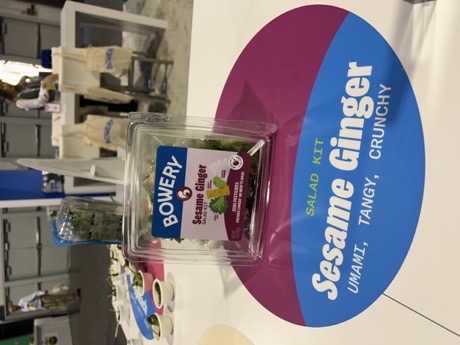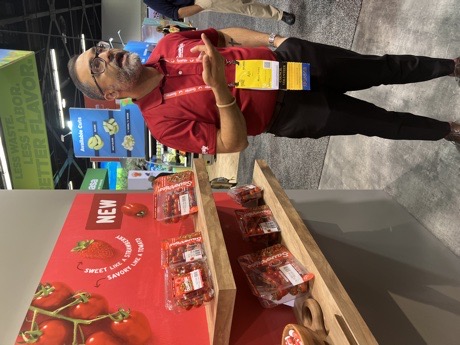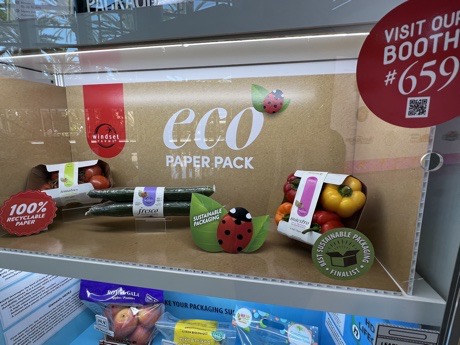10/30/2023
Global Produce & Floral Show Notes
Jennifer Polanz
Our Inside Grower crew made the trek to sunny (and warm) Anaheim, California, for the second annual Global Produce & Floral Show in October, where the world of produce met to set the trends, talk challenges and soak in a little Vitamin D (much needed for this Cleveland gal).
What’s Trending
It was clear right away there was one trend that continues to get trendier, both with conventional produce and indoor grown: salad kits. Holy cow, there were salad kits being introduced everywhere.
 Examples included Bowery’s salad kit bowls that they were shopping to potential buyers, with what will be flex film on top of a clamshell bottom (they didn’t have a prototype for the show), that are versatile and single serve.
Examples included Bowery’s salad kit bowls that they were shopping to potential buyers, with what will be flex film on top of a clamshell bottom (they didn’t have a prototype for the show), that are versatile and single serve.
Mastronardi Produce was highlighting its Queen of Greens leafy greens in a salad kit, 80 Acres Farms had their own fresh take, Gotham Greens (which had a head start with their own salad dressings) were previewing kits that they said were gaining lots of interest, and the list goes on and on.
If I may editorialize for a minute, I think these could be a differentiator for CEA-grown leafy greens and other components. We know our product is typically grown closer to consumer, meaning it will stay fresher longer, which is the key for convenience items like salad kits.
What was clear is convenience is a great way to get people to eat more fruits and veggies, and these types of products can go a long way to encouraging more sales. Plus, the more single serve there are, the more they will buy, which leads me to …
Melons! We’ve talked before about those crazy cats at Pure Flavor and their greenhouse melons—which are the only ones of its kind on the market today. Well, they’ve done it again and introduced a new melon, Oronai Sweet Charentais Melon, which is a personal serving size featuring the sweetness of a cantaloupe but without the musk (I tasted it and can confirm its deliciousness).
They'll sell them as two-packs (shown here) or individually, and currently they're grown in greenhouses in Mexico, but there are trials happening in Leamington, so we’ll keep you posted if they can grow these up north.
Pure Flavor also introduced a new sweet and juicy snacking tomato, Tiki. It’s already won a Superior Taste Award Certification from the International Taste Institute in Brussels.
 Mucci Farms showcased its new Savorries line of tomatoes that had a strawberry shape, high Brix, and best of all, is Rugose resistant. Communications Manager Ajit Saxena (pictured) told us they see vine-ripened and snacking tomatoes on the rise, so this hits all the right sweet spots, as it’s big enough to still cook with, but small enough to still snack on.
Mucci Farms showcased its new Savorries line of tomatoes that had a strawberry shape, high Brix, and best of all, is Rugose resistant. Communications Manager Ajit Saxena (pictured) told us they see vine-ripened and snacking tomatoes on the rise, so this hits all the right sweet spots, as it’s big enough to still cook with, but small enough to still snack on.
I had the pleasure of talking to the folks at Alexander Ranch, which is a hydroponic producer that has ties to the floriculture world through its sister companies, Westland Floral and Gallup & Stribling Orchids, both in Carpinteria. The hydroponic side grows lettuce, herbs and microgreens for grocery, wholesale distributors and restaurants. They were testing the market with a new edible flowers mix, which combines their connections to both industries.
I really liked this herb trio, called Counter Culture, from North Shore Living, a hydroponic producer that sells some of its product potted and others with the roots attached. This is a nice grab-and-go potted herb product for retail that consumers can keep on their counter and snip from while cooking. It comes in packs of three and contains the top herbs that consumers buy most often—in this case, basil, mint and thyme.
Sustainable Packaging Challenges
With convenience comes more packaging and that was one of the more prevalent topics at the show (along with labor and climate change). I sat in on a panel discussion about the challenges around sustainable packaging and it's a complex topic.
For example, what’s the overall goal? Is it to recycle more plastic and have a continuous loop? Is it to create packaging from plant materials that can be composted when needed (from the Earth back into the Earth)?
 The International Fresh Produce Association (the hosts of the show) has created a Sustainable Packaging Working Group to discuss these very issues and come together as an industry. It’s also an issue that won’t be determined internally—government regulations at multiple levels will be driving a lot of this change.
The International Fresh Produce Association (the hosts of the show) has created a Sustainable Packaging Working Group to discuss these very issues and come together as an industry. It’s also an issue that won’t be determined internally—government regulations at multiple levels will be driving a lot of this change.
For example, the EU is leading the discussion with its European Green Deal as it strives to become the first climate-neutral continent. They're not alone, though—Canada has a goal of Zero Plastic Waste. And here in the U.S. the federal government is focused on a Circular Economy to keep goods and materials in circulation longer so they don’t become waste, which includes a national recycling program.
The members of the panel also talked about how it depends on what the retailer wants—some are looking for compostable or biobased packaging, others recyclable.
What IS CEA? And Should We Keep Using the Term?
I sat in on another talk about indoor produce growing specifically, where IFPA Vice President of Innovation Vonnie Estes queried her panelists about the state of CEA. A few very interesting notes came out of this panel, including the idea that consistent messaging across indoor production would help everyone.
For example, do consumers understand what controlled environment agriculture means? What does indoor grown mean? Do you differentiate between greenhouse and vertical farm or container farming? If a consumer doesn’t understand how the product is grown, can they make an informed decision in the few seconds they're in front of the product at the grocery store?
Also, who’s responsibility is it to differentiate the product? The producer with packaging? Or the retailer with signage? These were all fascinating questions that the industry as a whole needs to talk about more.
Why? Because this industry is still a very small percentage of the much larger conventional, field-grown produce market. Vonnie asked her panelists when leafy green production will break 10% of the total marketshare, and while it wasn’t unanimous, the general thought was it would take until about 2030, with supply being the issue, not demand. It’s a matter of being able to scale up fast enough to meet continued demand. If growers coalesce around shared terminology and messaging, perhaps it would drive that growth faster?
The Overall Produce Sector
A couple of final thoughts to finish this Global Produce-themed newsletter out. IFPA CEO Cathy Burns gave her State of the Industry to kick the event off and it was eye-opening how engaged this organization hopes to be globally.
They'll be attending COP28 on climate change in Dubai in early December, and they recently held an advocacy event in Washington, D.C. to lobby Congress on the vital needs of the produce and floral industries. You can read more about their advocacy initiatives HERE, but one of the goals is to get more of the industry involved via the Advocacy Action Network (click the link to find out more and to sign up).
Why is it so vital? There are many challenges facing global produce and floral, from climate change to labor shortages, food deserts that prevent people from accessing fresh fruits and vegetables, and more.
Does all this sound fascinating to you? Want to experience it for yourself next year? Mark your calendars for October 17-19 in Atlanta for the 2024 Global Produce & Floral Show.